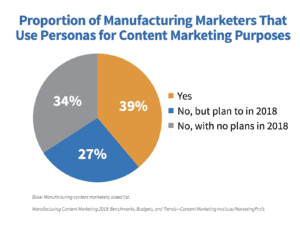As a manufacturer, you probably wear many hats at once. We talk to clients who are their company’s marketer, salesperson, production manager, and janitor. Even if that isn’t the case and you have a team who fills some of those roles for you, marketing in the manufacturing sector is challenging.With the ebbs and flows of the business, there is hardly enough time in the day to create content. So, where do you focus your marketing efforts to move the needle?
Seth Godin, in his recent book, This Is Marketing: You Can’t Be Seen Until You Learn To See talks about marketing in this way:
Marketing in 5 Steps
- The first step is to invent a thing worth making, with a story worth telling, and a contribution worth talking about.
- The second step is to design and build it in a way that a few people will particularly benefit from and care about.
- The third step is to tell a story that matches the built-in narrative and dreams of that tiny group of people, the smallest viable market.
- The fourth step is the one everyone gets excited about: spread the word.
- The last step is often overlooked: show up- regularly, consistently, and generously, for years and years – to organize and lead and build confidence in the change you seek to make. To learn permission to follow up and to earn enrollment to teach.
Focus on Telling Your Story to Your Smallest Viable Market
WHO IS THIS FOR?
Know Your Audience, Match Your Story
 Marketing Institute, Manufacturing Content Marketing 2019: Benchmarks, Budgets, and Trends, only half of manufacturing marketers prioritize their audience’s informational needs over their sales/promotional message while creating content.
Marketing Institute, Manufacturing Content Marketing 2019: Benchmarks, Budgets, and Trends, only half of manufacturing marketers prioritize their audience’s informational needs over their sales/promotional message while creating content.“It doesn’t make any sense to make a key and then run around looking for a lock to open. The only productive solution is to find a lock and then fashion a key. It’s easier to make products and services for the customers you seek to serve than it is to find customers for your products and services.”
How to Create Personas
 Many B2C marketers build personas when they first begin their company, but often do not update them. Your audience may shift over time. It’s worth revisiting personas at least once a year to consider new insights into these profiles, and remove or add those as it makes sense. Whether you’ve created personas in the past, or have yet to build them, the process of creation is relatively simple.
Many B2C marketers build personas when they first begin their company, but often do not update them. Your audience may shift over time. It’s worth revisiting personas at least once a year to consider new insights into these profiles, and remove or add those as it makes sense. Whether you’ve created personas in the past, or have yet to build them, the process of creation is relatively simple.Get your key leadership team together as well as key managers and floor staff. Each of these people interacts with your customers in a different scenario and can shed light on new insights that others at different levels in the organization may not have. Work through the key questions to build a set of personas that resonate with everyone. There will likely be more than one.
You may have gaps in knowledge – don’t be afraid to pick up the phone and talk to key customers to fill those gaps. Understand why they buy from you, and what keeps them coming back. Try to understand the journey they took to get to you. Feel free to download the persona worksheet to get you started.
Spend some time working through this process, and use your results to inform your marketing strategy going forward. You might be surprised how better understanding your audience shapes your customer service, your sales process, and even your business operations.
A Look At Manufacturers Who Know Their Audience
Essential Wholesale and Labs is a great example of a brand who knows their target customer and makes content that serves them, adding value along the way. Take a look at their resources page for customer tutorials, how-tos and more. The boxmaker is another b2b company who does a great job adding value for their customers. From the story they tell about their production process, to the resources they provide prospects and customers, they’re creating a positive experience and showing their willingness to partner in helping clients solve challenges.
Armed with a deep understanding of who your core customers are you will have the focus you need to craft messages, events, content, brochures, and other collateral that will share your story in a way that makes sense.



